Updated 2007.
Bacterial spot of pepper and tomato
Xanthomonas euvesicatoria and Xanthomonas perforans = [Xanthomonas axonopodis (syn. campestris) pv. vesicatoria], Xanthomonas vesicatoria, and Xanthomonas gardneri
Pepper (Capsicum spp.) and tomato (Solanum lycopersicum) (economically important hosts)
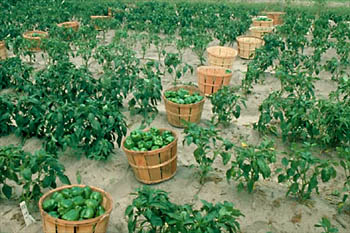
Defoliation and reduced fruit yield from bacterial spot (background).
Symptoms and signs
Bacterial spot occurs on peppers and tomatoes. Many of the disease features are similar for both crops. The focus of the information presented here is on pepper. Worldwide, 16.5 million metric tons (36 million tons) of peppers are grown for fresh consumption and for use in condiments. For many people in the U.S., the bell-shaped pepper fruit is the most familiar (Figure 1); however, non-bell-type peppers (Figure 2) are more widely grown.

Figure 1 |
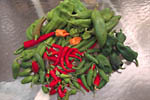
Figure 2 |
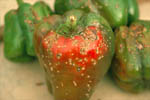
Figure 3 |
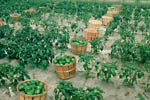
Figure 4 |
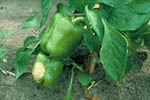
Figure 5 |

Figure 6 |
Bacteria attack the foliage, stems, and fruit of peppers and tomatoes. On peppers, lesions may form on fruit, including the peduncle (Figure 3), but the major crop loss (Figure 4) results from shedding of blossoms and young, developing fruit. Fruit that remain are usually non-marketable because of poor quality. They may have lesions and are often misshapen and damaged from excessive exposure to the sun as a result of defoliation. This can result in sunscald on the fruit (Figure 5). Diseased leaves drop prematurely resulting in extensive defoliation. As newly emerging leaves become infected and defoliation of older, diseased leaves continues, plants possess leaves mostly on their upper stems (Figure 6). Generally, defoliation is more common for peppers than for tomatoes. Because the diseased foliage often remains on tomato plants, affected plants may have a scorched appearance (Figure 7).
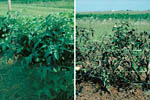
Figure 7 |
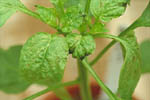
Figure 8 |
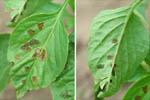
Figure 9 |
Leaves
Because the most obvious symptoms occur on leaves, the disease is often referred to as "bacterial leaf spot." Symptoms begin as small, yellow-green lesions on young leaves which usually appear deformed and twisted (Figure 8), or as dark, water soaked, greasy-appearing lesions on older foliage (Figure 9). Lesions develop rapidly to a size of 0.25 to 0.5 cm (0.1 to 0.2 in.) wide and become tan to brownish-red. Lesion shape is defined by leaf veinlets, so the shape is angular rather than the round shape that is more typical of fungal leaf spots or injury caused by some pesticides or other chemical sprays.
Lesions often are more numerous at the tip and margin of the leaf where moisture such as dew is retained (Figure 10). Under dry conditions, diseased leaves can develop a tattered appearance as the leaf margin and lesion centers become necrotic, dry up and disintegrate. Lesion size is often larger and symptoms are more severe when extended periods (> 12 hours) of moisture-saturated tissue occur.
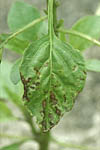
Figure 10 |

Figure 3 |
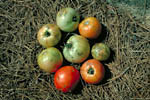
Figure 11 |
Fruit
Fruit spots (up to 0.5 cm, 0.2 in.) begin as pale-green, water-soaked areas, which eventually become raised, brown, and roughened on pepper (Figure 3) and tomato (Figure 11) fruit. Spots may provide entrance points for various fungal and other bacterial invaders that can cause secondary fruit rots. The bacterial spot pathogen alone does not cause fruit rot.
Pathogen Biology
Pathogen characteristics
Bacterial spot is caused by several species of gram-negative bacteria in the genus Xanthomonas. In culture, these bacteria produce yellow, mucoid colonies (Figure 12). A "mass" of bacteria can be observed oozing from a lesion by making a cross-sectional cut through a leaf lesion, placing the tissue in a droplet of water, placing a cover-slip over the sample, and examining it with a microscope (~200X) (Figure 13).
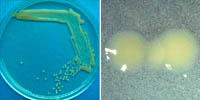
Figure 12 |
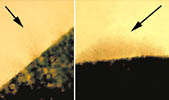
Figure 13 |
Pathogen classification and hosts
Bacterial spot was first observed on tomato in South Africa as early as 1914. For almost half a century, a single bacterial species, classified as Xanthomonas vesicatoria and later as X. campestris pv. vesicatoria, was considered the cause of bacterial spot of both pepper and tomato. In the early 1990s, it was shown that two distinct genetic groups (possibly species) existed within strains of pv. vesicatoria. In 1995, Vauterin et al. restructured the classification of the genus Xanthomonas by proposing species status for these groups: X. vesicatoria and X. axonopodis (syn. campestris) pv. vesicatoria. More recently, it has been shown that bacteria belonging to four distinct groups (previously designated A, B, C, and D) cause bacterial spot. Jones et al. (2004) proposed that these should have species status: X. euvesicatoria = X. campestris (axonopodis) pv. vesicatoria (group A), X. vesicatoria = X. vesicatoria (group B), X. perforans = group C strains, and X. gardneri = group D strains. Strains of groups A and B are most widely distributed. The vast majority of strains that infect pepper are in group A and possibly some in groups B and D. No pepper strains have been found in group C; however, strains from all four groups have been isolated from tomato. Some strains infect only pepper (designated pepper strains), some infect only tomato (designated tomato strains), and some can infect both pepper and tomato (designated pepper/tomato strains). The host range of the different strains can be determined by infiltrating a bacterial suspension into the leaf and observing the response. Within 18 to 36 hours, a resistant response is indicated by a rapid collapse of the infiltrated area (a hypersensitive response, HR) (Figure 14). In a susceptible plant, the infiltrated area develops a chlorotic, water-soaked appearance, but not until 3 to 5 days after infiltration.
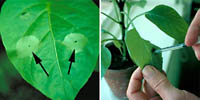
Figure 14 |
Disease Cycle and Epidemiology
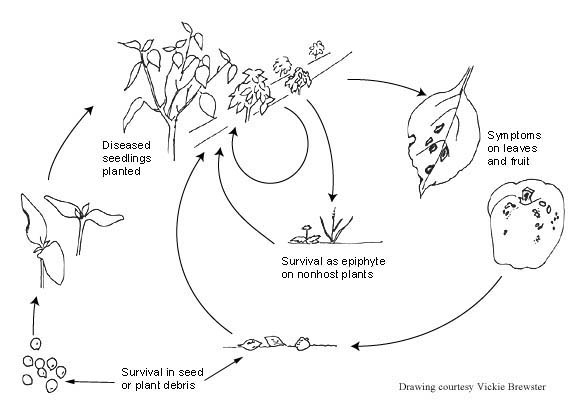
Disease Cycle |
The bacteria have a very limited survival period of days to weeks in the soil, and thus their survival is almost always in association with debris from infected or diseased plants. The pathogens have been reported to persist in association with roots of wheat as well as a few weed species; weeds, however, are considered to play only a minor role in pathogen survival. Volunteer tomato plants and possibly pepper volunteers are potentially important sources of inoculum in some locations. In colder regions where vegetative material is killed, the bacteria survive very poorly, if at all. In these areas, reintroduction is primarily on contaminated seed or infected transplants.
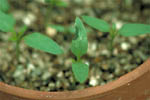
Figure 15 |
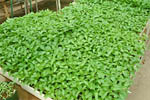
Figure 16 |
The pathogen can survive in association with seed, either externally or internally. On externally infested seed, cotyledons may become infected upon contact with the seed coat and exhibit lesions soon after emerging from the soil (Figure 15). Bacteria are then readily splashed to new foliage and to other plants. Disease is a particular threat in transplant production (Figure 16). Transplant beds favor bacterial spot development because plants are irrigated frequently, crowded together, and humidity is typically high. In a 24-hr period, the bacteria can multiply rapidly and produce millions of cells. The risk of transmission on the seed surface can be reduced by treating seed with sodium or calcium hypochlorite or trisodium phospate (TSP). Killing bacteria that may be carried internally is more difficult. Chemical or heat treatments that kill the pathogen within the seed also can injure or kill the seed.
Although bacterial spot is a disease of warm, humid regions, it can develop in arid, irrigated regions. The bacteria can be spread by rain or by overhead irrigation. Bacteria also may be spread in water droplets when pesticides are applied with high-pressure sprayers.
Bacteria enter through stomata on the leaf surfaces and through wounds on the leaves and fruit, such as those caused by abrasion from sand particles and wind. Prolonged periods of high relative humidity favor infection and disease development. Symptom development is delayed or eliminated when relative humidity remains low for several days after infection.
Management of Bacterial Spot of Pepper and Tomato
The primary management strategy of bacterial spot begins with use of certified pathogen-free seed and disease-free transplants. The bacteria do not survive well once host material has decayed, so crop rotation is recommended. Once the bacteria are introduced into a field or greenhouse, the disease is very difficult to control.
Pepper plants are routinely sprayed with copper-containing bactericides to maintain a "protective" cover on the foliage and fruit (Figure 17). Strains of the pathogen resistant to copper and/or streptomycin are fairly common and can be detected by plating bacteria on media containing these compounds (Figure 18). Genes encoding resistance to copper and streptomycin can be borne on plasmids (extrachromosomal DNA) contained in the bacterial cells. The presence of these genes on plasmids allows for the rapid spread of resistance to other non-resistant bacteria.
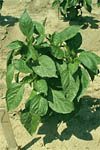
Figure 17 |

Figure 18 |
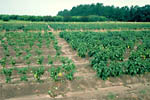
Figure 19 |
Although resistant cultivars are available and widely planted, there are strains of the pathogen able to overcome all of the currently known major resistance genes (Figure 19). Currently, three independently segregating genes form the basis for resistance to bacterial spot in commercial cultivars of bell peppers. Strains of the pathogen that react differently with the resistance genes of the pepper plant are designated as races. With the report of a fourth resistance gene in 1998, 11 races can be differentiated using peppers. Resistance has not been as easy to find and use in tomato. Formerly, four races were recognized that infect tomato. With the proposed taxonomic changes, these have assumed species status (Jones, et al. 2004).
Biological control options for bacterial spot are limited. However, a biological control method that uses bacterial viruses (bacteriophages) that specifically kill the bacterial pathogens is now available. Treatments with these bacteriophages, marketed as “AgriPhage,” have been successful in reducing disease, especially in greenhouse transplant production.
Significance
Bacterial spot is one of the most devastating diseases of pepper and tomato. The disease occurs worldwide where pepper and tomato are grown in warm, moist areas. When it occurs soon after transplanting and weather conditions remain favorable for disease development, the results are usually total crop loss. Current chemical control is limited to copper or copper combined with maneb sprays that provide only marginal success thus making the disease very difficult to control once the epidemic is underway. When the disease occurs in commercial pepper fields early in the season, some farmers destroy the entire crop by disking because it is so difficult and economically costly to control once present in the field.
The study of this pathogen also has significantly increased fundamental understanding of host-pathogen interactions and the gene-for-gene model theory at the molecular level. Simply defined, this model states that for each resistance gene in the host there is a corresponding avirulence gene in the pathogen. An avirulence gene (also termed "effector gene") encodes a product that interacts directly, or more likely indirectly, with a product encoded by the corresponding resistance gene in the plant; this interaction triggers resistance. In plants lacking the corresponding resistance gene, effector gene products suppress innate host defenses. In pepper carrying one of these resistance genes, resistance is expressed as a hypersensitive response (Figure 14). A bacterial avirulence gene(s) can be lost or can mutate. This genetic change in the pathogen allows race changes that overcome resistance in the host, and, consequently, the host range of the pathogen is expanded. The known avirulence genes in the bacterial spot pathogens of pepper and tomato have been cloned and the DNA sequence determined for most of them. Their study has improved understanding of pathogen host range and genetic resistance. Recently the complete genome of a strain of the pathogen also was sequenced, leading to a better understanding of the mechanisms that allow a microbe to behave as a plant pathogen.

Figure 14 |
Selected References
Balogh, B., J.B. Jones, M.T. Momol, S.M. Olson, A. Obradovic, P. King, and L.E. Jackson. 2003. Improved efficacy of newly formulated bacteriophages for management of bacterial spot on tomato. Plant Disease 87: 949-954.
Bouzar, H., J.B. Jones, R.E. Stall, F.J. Louws, M. Schneider, J.L.W. Rademaker, F.J. de Bruijn, and L.E. Jackson. 1999. Multiphasic analysis of xanthomonads causing bacterial spot disease on tomato and pepper in the Caribbean and Central America: Evidence for common lineages within and between countries. Phytopathology 89:328-335.
DeWitt, D. and N. Gerlach. 1990. The Whole Chile Pepper Book. Little, Brown and Co., Boston.
Jones, J.B. 1991. Bacterial spot. Page 27 in: Compendium of Tomato Diseases. J.B. Jones, J.P. Jones, R.E. Stall, and T.A. Zitter, eds. American Phytopathological Society, St. Paul, MN.
Jones, J.B., R.E. Stall, and H. Bouzar. 1998. Diversity among xanthomonads pathogenic on pepper and tomato. Annual Review of Phytopathology 36:41-58.
Jones, J.B., G.H. Lacy, H. Bouzar, R.E. Stall, and N.W. Schaad. 2004. Reclassification of the xanthomonads associated with bacterial spot disease of tomato and pepper. Systematic and Applied Microbiology 27: 755-762.
Kousik, C.S. and D.F. Ritchie. 1996. Race shift in Xanthomonas campestris pv. vesicatoria within a season in field-grown pepper. Phytopathology 86:952-958.
Minsavage, G.V., D. Dahlbeck, M. Whalen, B. Kearney, U. Bonas, B.J. Staskawicz, and R.E. Stall. 1990. Gene-for-gene relationship specifying disease resistance in Xanthomonas campestris pv. vesicatoria-pepper interactions. Molecular Plant-Microbe Interactions 3:41-47.
Jones, J.B. and K. Pernezny. 2003. Bacterial spot. Pages 6-7 in: Compendium of Pepper Diseases. K. Pernezny, P.D. Roberts, J.F. Murphy, and N.P. Goldberg, eds. American Phytopathological Society, St. Paul, MN.
Sahin, F. and S.A. Miller. 1996. Characterization of Ohio strains of Xanthomonas campestris pv. vesicatoria, causal agent of bacterial spot of pepper. Plant Disease 80:773-778.
Swords, K.M.M., D. Dahlbeck, B. Kearney, M. Roy, and B.J. Staskawicz. 1996. Spontaneous and induced mutations in a single open reading frame to both virulence and avirulence in Xanthomonas campestris pv. vesicatoria avrBs2. Journal of Bacteriology 178:4661-4
669.
Vauterin, L., B. Hoste, K. Kersters, and J. Swings. 1995. Reclassification of Xanthomonas. International Journal of Systematic Bacteriology 45:472-489.
